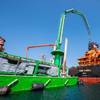Clariant & Siemens To Promote New Sour Gas Shift Technology
Siemens Energy and Clariant, a world leader in specialty chemicals, signed an agreement to cooperate in the commercialization of a new, jointly developed sour gas shift (SGS) technology for coal gasification. The agreement appoints Clariant as the exclusive catalyst supplier for all projects where Siemens offers sour gas shift ("SGS") systems. While the collaboration covers all global projects, commercialization will focus on China – the region with the highest growth rate of coal-to-chemical projects.
Stefan Heuser, Head of the Catalysts Business Unit at Clariant, stated: "This global cooperation is a very important step in marketing our innovative catalysts for coal-to-chemical applications. With its strong commercialization focus on China, the cooperation supports Clariant's strategy to increase our presence in the growing markets of Asia."
Frank Hannemann, Head of Technology of Fuel Gasification Business at Siemens, declared: "This advanced technology makes coal to chemical plants more competitive and environmentally friendly. This global cooperation enhances the broad acceptance of gasification plants in China and in growing markets around the world."
The advanced SGS technology from Clariant and Siemens significantly decreases total capital cost for coal-to-chemical and IGCC applications through optimization and simplification of total plant concepts. This is achieved by combining the strengths of both companies: The entrained-flow Siemens Fuel Gasifier (SFG) is able to produce syngas from a wide range of fuels - even for low ranks of coal. Clariant's ShiftMax® 821 catalyst enables a simple, once-through process without further adjustment of the exit gas from the gasifier. The simplified layout uses smaller and fewer reactors, and requires no steam adjustment for temperature control. This reduces capital expenditure for the shift system by up to 20%, and optimizes operating costs with up to 30% lower catalyst volume. The new technique can handle different steam-to-gas ratios and high carbon monoxide content in the gas, resulting in improved availability and reliability of the whole process. Furthermore, it is an inherently safe method. Thanks to steam-independent control of the exothermal reaction, there is no risk of temperature run-away reactions.













